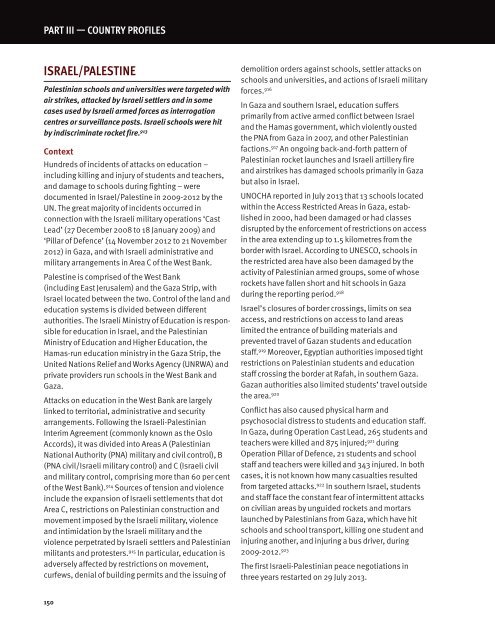You also want an ePaper? Increase the reach of your titles
YUMPU automatically turns print PDFs into web optimized ePapers that Google loves.
PART III — COUNTRY PROFILeS<br />
ISRAeL/PALeSTINe<br />
Palestinian schools and universities were targeted with<br />
air strikes, attacked by Israeli settlers and in some<br />
cases used by Israeli armed forces as interrogation<br />
centres or surveillance posts. Israeli schools were hit<br />
by indiscriminate rocket fire. 913<br />
Context<br />
Hundreds of incidents of attacks on education –<br />
including killing and injury of students and teachers,<br />
and damage to schools during fighting – were<br />
documented in Israel/Palestine in 2009-2012 by the<br />
UN. The great majority of incidents occurred in<br />
connection with the Israeli military operations ‘Cast<br />
Lead’ (27 December 2008 to 18 January 2009) and<br />
‘Pillar of Defence’ (14 November 2012 to 21 November<br />
2012) in Gaza, and with Israeli administrative and<br />
military arrangements in Area C of the West Bank.<br />
Palestine is comprised of the West Bank<br />
(including East Jerusalem) and the Gaza Strip, with<br />
Israel located between the two. Control of the land and<br />
education systems is divided between different<br />
authorities. The Israeli Ministry of Education is responsible<br />
for education in Israel, and the Palestinian<br />
Ministry of Education and Higher Education, the<br />
Hamas-run education ministry in the Gaza Strip, the<br />
United Nations Relief and Works Agency (UNRWA) and<br />
private providers run schools in the West Bank and<br />
Gaza.<br />
Attacks on education in the West Bank are largely<br />
linked to territorial, administrative and security<br />
arrangements. Following the Israeli-Palestinian<br />
Interim Agreement (commonly known as the Oslo<br />
Accords), it was divided into Areas A (Palestinian<br />
National Authority (PNA) military and civil control), B<br />
(PNA civil/Israeli military control) and C (Israeli civil<br />
and military control, comprising more than 60 per cent<br />
of the West Bank). 914 Sources of tension and violence<br />
include the expansion of Israeli settlements that dot<br />
Area C, restrictions on Palestinian construction and<br />
movement imposed by the Israeli military, violence<br />
and intimidation by the Israeli military and the<br />
violence perpetrated by Israeli settlers and Palestinian<br />
militants and protesters. 915 In particular, education is<br />
adversely affected by restrictions on movement,<br />
curfews, denial of building permits and the issuing of<br />
demolition orders against schools, settler attacks on<br />
schools and universities, and actions of Israeli military<br />
forces. 916<br />
In Gaza and southern Israel, education suffers<br />
primarily from active armed conflict between Israel<br />
and the Hamas government, which violently ousted<br />
the PNA from Gaza in 2007, and other Palestinian<br />
factions. 917 An ongoing back-and-forth pattern of<br />
Palestinian rocket launches and Israeli artillery fire<br />
and airstrikes has damaged schools primarily in Gaza<br />
but also in Israel.<br />
UNOCHA reported in July 2013 that 13 schools located<br />
within the Access Restricted Areas in Gaza, established<br />
in 2000, had been damaged or had classes<br />
disrupted by the enforcement of restrictions on access<br />
in the area extending up to 1.5 kilometres from the<br />
border with Israel. According to UNESCO, schools in<br />
the restricted area have also been damaged by the<br />
activity of Palestinian armed groups, some of whose<br />
rockets have fallen short and hit schools in Gaza<br />
during the reporting period. 918<br />
Israel’s closures of border crossings, limits on sea<br />
access, and restrictions on access to land areas<br />
limited the entrance of building materials and<br />
prevented travel of Gazan students and education<br />
staff. 919 Moreover, Egyptian authorities imposed tight<br />
restrictions on Palestinian students and education<br />
staff crossing the border at Rafah, in southern Gaza.<br />
Gazan authorities also limited students’ travel outside<br />
the area. 920<br />
Conflict has also caused physical harm and<br />
psychosocial distress to students and education staff.<br />
In Gaza, during Operation Cast Lead, 265 students and<br />
teachers were killed and 875 injured; 921 during<br />
Operation Pillar of Defence, 21 students and school<br />
staff and teachers were killed and 343 injured. In both<br />
cases, it is not known how many casualties resulted<br />
from targeted attacks. 922 In southern Israel, students<br />
and staff face the constant fear of intermittent attacks<br />
on civilian areas by unguided rockets and mortars<br />
launched by Palestinians from Gaza, which have hit<br />
schools and school transport, killing one student and<br />
injuring another, and injuring a bus driver, during<br />
2009-2012. 923<br />
The first Israeli-Palestinian peace negotiations in<br />
three years restarted on 29 July 2013.<br />
150


